Wellbeing: A Bottom Line Issue
How Feeling Good At Work Drives Business Performance
When IBM asked CEOs around the world to identify the most important leadership traits needed today, their answer was resounding: collaborative, communicative, creative and flexible. CEOs are seeking “employees with the ability to constantly reinvent themselves. These employees are comfortable with change; they learn as they go, often from others’ experiences,” notes the study. Driving the need for these skills is the complexity of problems that organizations face today, and the demand for innovation that is no longer the turf of elite, top brands. Innovation is critical to drive bottom line results.
But here’s the new dilemma that CEOs face: collaboration, communication, creativity and flexibility are a set of behaviors that require leadership skills, metrics and mindsets that are different from what many business leaders have learned in the past. For decades, business schools churned out young leaders who were well trained in areas such as logistics, supply chain management, analysis and the like. Only recently are organizations recognizing that those business fundamentals aren’t enough on their own. They also need to create an environment and culture in which the necessary new behaviors can thrive.

Fostering creativity and innovation requires a new strategy that might take some business leaders by surprise—a rigorous focus on organizational and employee wellbeing. “The most successful organizations are now turning their attention to employee wellbeing as a way to gain emotional, financial and competitive advantage,” notes Tom Rath, Gallup’s leader of workplace research and co-author of the bestselling book “Wellbeing.”
Rath and other leading thinkers on the topic point out that employee wellbeing is a distinctly different notion than “wellness,” which focuses narrowly on physical health and is currently the primary area where businesses turn their attention. In the United States, wellness programs have been driven by the need to control health care costs commonly borne by the employer. In other countries around the world, businesses and governments are also seeking to control the rising economic costs of physical and mental illness in the workforce.
An Assault on Wellbeing
Organizations have strong reasons to be preoccupied with physical wellness, given its clear connection to costs. Worldwide, rates of heart and lung disease, diabetes and obesity are rising sharply. The United Nations Food and Agricultural Organization (FAO) found Mexico has a 32.8% adult obesity rate, surpassing the U.S. at 31.8%. There are now about 1.5 billion overweight people in the world, and at least 25% of them are in China, according to the Duke University Global Health Institute. In Mexico, Type 2 diabetes is the leading cause of adult deaths, says a 2011 study by the World Economic Forum and Harvard School of Public Health.
“The most successful organizations are now turning their attention to employee wellbeing as a way to gain emotional, financial and competitive advantage.”
Tom RathAuthor of Wellbeing
At the same time that declining physical health poses a growing risk for employers, the ubiquity of technologies is driving people to multitask like never before, leading to cognitive overload. According to author, researcher and Harvard educator Shawn Achor, our senses receive 11M bits of information every second, but the conscious brain can effectively process only 40 bits of information. Switching from one task to another makes it difficult to tune out distractions and can cause mental blocks that reduce a person’s productive time by as much as 40%, according to research reported by the American Psychological Association.
In addition to cognitive costs, stress is a strong contributor to the explosion of “developed nation” diseases throughout the world. Rapid changes in the work people do, the tools and the technology they use have made work more complex, demanding and stressful. “How fast” and “how much” have taken on new dimensions, and work easily blends into life away from the workplace. These factors are all powerful catalysts for employee burnout and other signs of ill-being, making wellbeing a form of risk management.
In the United Kingdom, research by the Centre for Mental Health puts the costs of mental health-related presenteeism (at work physically but unproductive mentally) at £15 billion per year—almost twice the cost of absence. The European Agency for Safety and Health at Work cites stress as a factor in at least half of all lost working days. Stress in the workplace is now emerging in the developing world, too, according to a 2011 report in Le Monde newspaper: “Countries from Asia and the southern hemisphere are now carefully—and officially—looking at the psycho-social problems and economic consequences linked to work-induced stress.”
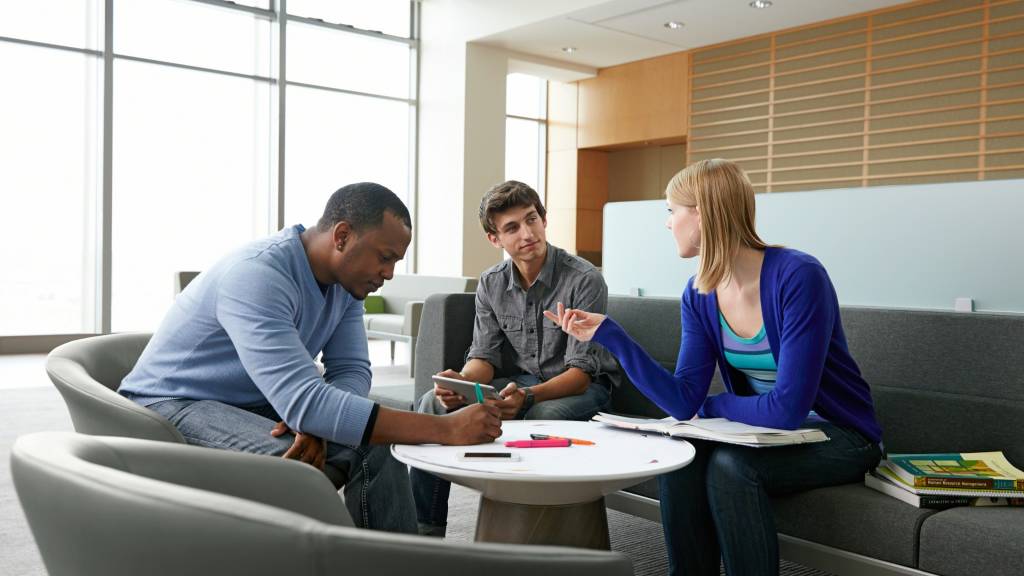
To understand the positive drivers of wellbeing, Steelcase WorkSpace Futures researchers in Europe, North America and Asia recently delved deeply into the topic, exploring the role of the physical workplace in shaping employee behavior to foster wellbeing. After synthesizing years of Steelcase primary research and investigating globally diverse notions of wellbeing, the team came to a distinct conclusion: Wellbeing is systemic and holistic, integrating many dimensions, including the physical, cognitive and psychological needs of people. The team went on to conclude that the places where people come together to work can be designed to have a positive impact on a variety of dimensions of worker wellbeing.
“Bad health outcomes can lead to poor business outcomes in regard to absenteeism, presenteeism, accidents and increased costs, so there’s been significant focus on prevention,” says Beatriz Arantes, a Steelcase researcher who co-led a recent exploration of worker wellbeing. At the same time, Arantes says, there’s a growing awareness that being focused on wellbeing as a defensive measure has limited impact as a business strategy.
“Physical wellness is a critically important area of concern,” notes Nicholas de Benoist, who collaborated with Arantes and others in Steelcase’s exploration. “But focusing on just physical wellness can actually be detrimental to people’s overall wellbeing. At an organizational level, a myopic attention to physical wellness only misses the bigger business opportunity: Employee wellbeing is a critical pathway to achieving the creativity and innovation that organizations require to be successful today.”
And progressive employers are getting the message. “Today we’re seeing a surge of interest in wellbeing with some organizations in a more proactive sense,” notes Arantes. “Companies are interested in driving greater innovation. They’re betting they can reap positive results with a more creative, engaged and innovative workforce. In a knowledge-based, global economy, investing in wellbeing is completely in the interest of doing business.”
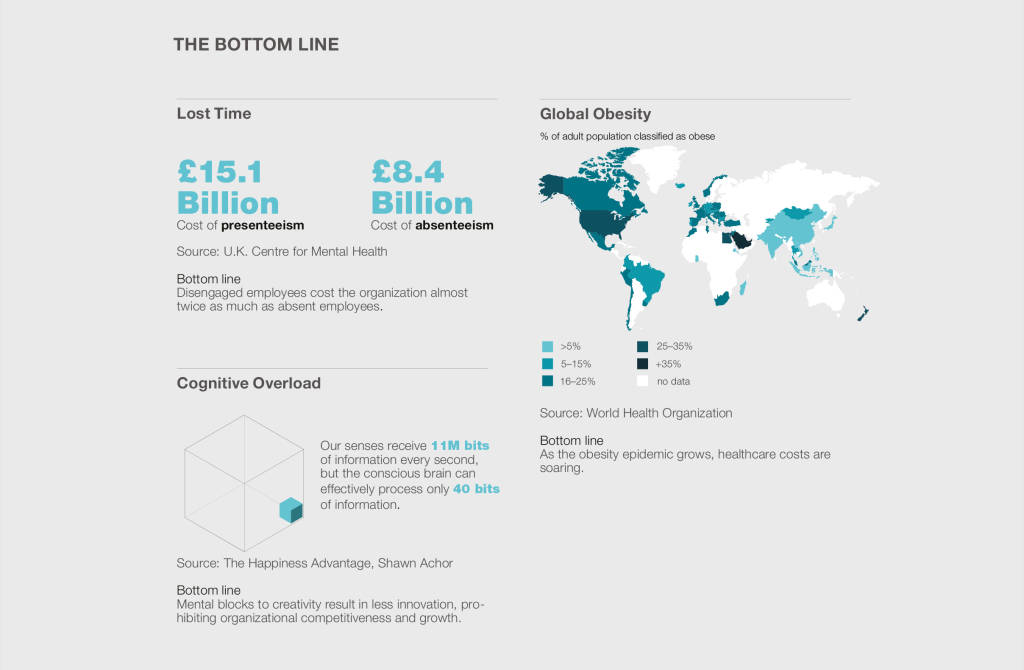
A Holistic View: Body Mind Environment
When businesses turn their attention to the assault on their employees’ wellbeing, it’s not surprising they often begin with physical health and ergonomics. In addition to the focus on employee health factors such as obesity, smoking cessation and exercise, many organizations are also focused on workplace ergonomics to prevent injury.
The ascent of ergonomics in the 1980s resulted in deep understandings of biomechanics and the importance of providing posture support for workers. In the 1980s when the focus was on maintaining a static, neutral posture for office workers using desktop computers, Steelcase breakthrough research established the importance of dynamic support that mimicked the movement of the spine and set a new industry standard for ergonomic seating.
Steelcase researchers went on to study the importance of movement, and began encouraging workers to intersperse standing and walking with sitting throughout the day. Recent studies performed by Marc T. Hamilton (2007), Pedersen (2009) and Stephens (2010) have shed new light on the relationship between long periods of sedentary behavior and pervasive health problems such as weight gain, metabolic syndrome and diabetes. Prolonged static sitting is now known to be physically demanding in its own way — disrupting metabolic functions and weakening the body’s defenses. Even working out in a gym after sitting all day won’t reverse its negative effects.
Meanwhile, technology devices are tempting people to sit even longer in chairs that were designed before tablets and other handhelds came into the office mainstream. This is leading to new work postures, some of which are leading to more pain.
“Ergonomic issues should always be top of mind for employers,” says Kevin Butler, a senior ergonomist at Steelcase. “Upper-extremity issues, especially pain in the neck and shoulders, are becoming more common all the time as a result of people constantly peering down at their handheld devices.”
Butler points out the need for workplaces to be designed for a palette of postures – a variety of work settings where people can choose to sit, stand, walk, perch or even squirm. But Butler warns that not all postures are created equal.
“Some postures are inherently bad for the body and should not be encouraged,” he notes. “I’ve seen workplaces that are designed to be fun, creative and have a great vibe, but sometimes they have terrible ergonomics. That’s not a solution that’s good for individuals or organizations.”
People need a range of choices and ergonomic supports. It’s important they have an environment they can move around in since movement throughout the day is important; and when they’re seated it’s equally as important that the chair they sit in supports them in the ways they work today.
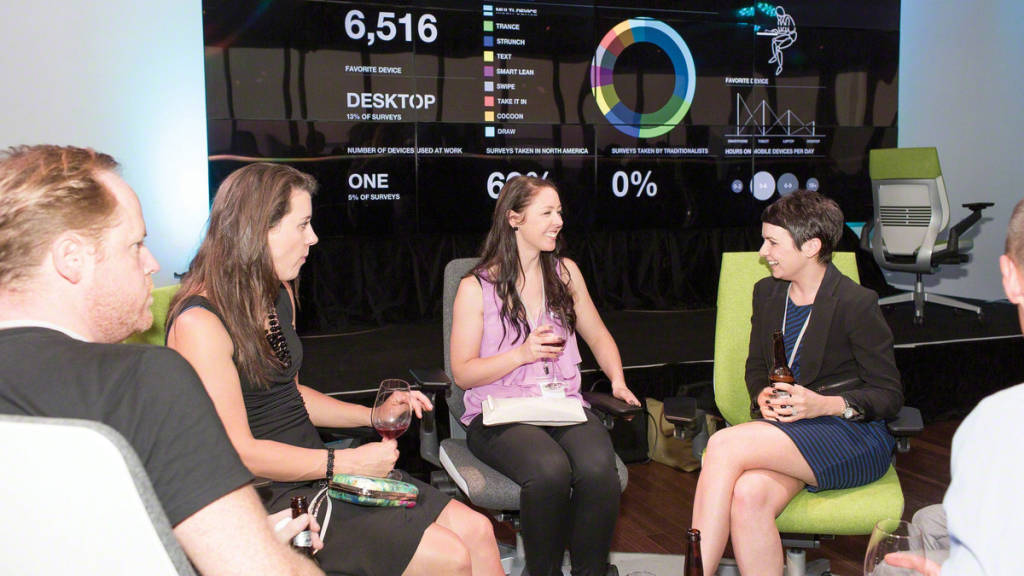
Researchers and designers at Gensler, a leading global architecture, design, planning and consulting firm, agree: Wellbeing is multifaceted. Unfortunately, many employers still make sizeable investments in physical wellbeing and then consider the problem solved, says Nila R. Leiserowitz, FASID, IIDA, Gensler’s regional managing principal in Chicago who spearheads the firm’s global endeavors in the health and wellness sector. “People think that if they have fitness centers, they’ve taken care of all the aspects of wellbeing. But that’s just one piece of what you need to consider. It’s not just a fitness center or a chair you can adjust. It’s not just about looking at your physical space. Wellbeing cuts across your culture, your HR strategies and the environment. It’s a symbiotic ecosystem.”
The Mind/Body Connection
As organizations face increasingly complex problems, they are recognizing that wellbeing is multifaceted and seeing a link between body and mind. Today scientists are studying the interdependence of our physical and mental states, and how our senses impact cognition.
Researchers are finding that our sense of touch — whether a surface is hard or soft, rough or smooth, for example — can impact how we perceive an unrelated interpersonal interaction. Another factor that significantly impacts cognitive wellbeing is noise. It can have undesirable physiological, psychological and behavioral effects, according to Julian Treasure, chairman of a United Kingdom-based consultancy, The Sound Agency. Background noise in the workplace has been found to increase employees’ stress hormone levels and undermine short-term memory, reading comprehension and willingness to engage with others, he says.
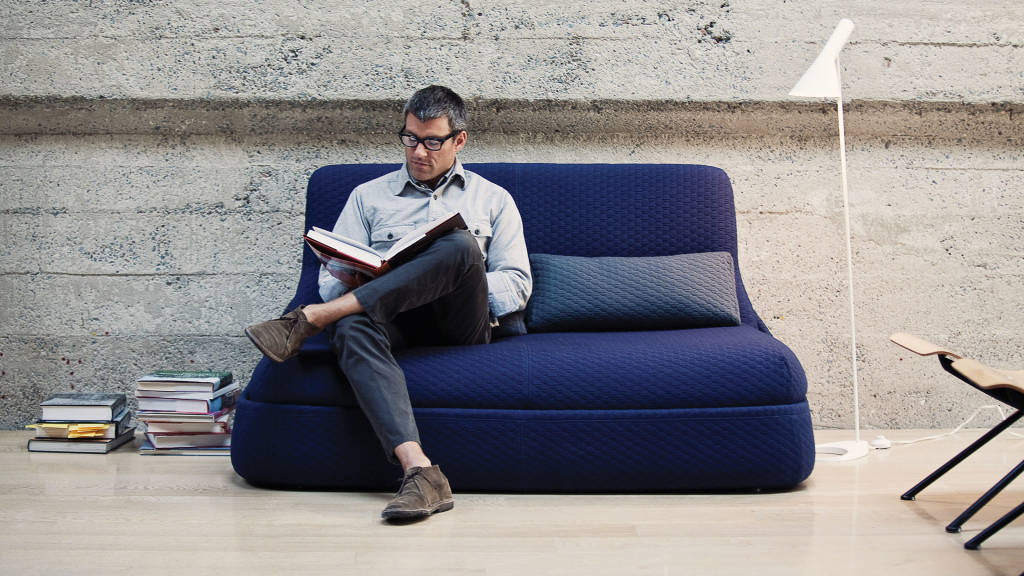
In workplaces, irritating noise can come from all kinds of sources: air conditioning, obnoxious ringtones, traffic, nearby construction, “pink noise” sound-masking and – especially – from other people’s voices.
“Cognitively, there is plenty of research now that shows that in loud offices in particular the most destructive sound of all is other people’s conversations,” says Treasure.
Noisy environments tend to only get worse over time, because people start speaking louder as it gets noisier around them (the Lombard effect). As a result of too much noise in the workplace, health and productivity can suffer— the latter by as much as 66%, according to one study that Treasure cites.
At the same time, he says, open-plan environments can be very good for many types of work. “It’s one way of working, but it’s not the only way. We need to give people spaces that match what they need to do.” And, conversely, the sounds of silence in the workplace can be too much of a good thing. Pin-drop-quiet places are intimidating, he says, because you can clearly hear every sound in them.
The solution, says Treasure, is a variety of workplace environments, each designed with consciousness of sound for the task and the people using the spaces. Work environments need to be designed not just for appearance, but for experience in all the senses.
In a time where the term “cognitive overload” has gone mainstream, researchers at The University of California and other institutions are studying how cognitive processes are linked to the body’s interaction with its surroundings. Their work shows how people do better when they can offload cognitive work onto the environment because of limits on attention or memory. At its most basic level, physical environments equipped with whiteboards make it easier for people to offload information by giving them a place to make their work visible. Going further, researchers at Steelcase are exploring how technology-enabled architectural elements and furniture allow the physical environment to take on routine tasks, such as anticipating when to turn on equipment. Being able to offload some functions onto the environment can free up brain capacity to tackle complex problems.
Feeling Good at Work
Gallup’s global wellbeing study explored a powerful body/mind connection: engagement. Being disengaged, they found, is a leading indicator for a subsequent diagnosis of depression, as well as an increase in total cholesterol and triglyceride levels. Perhaps even more alarming for businesses is that Gallup found more than two-thirds of workers around the world are simply waiting for the workday to come to an end; they become increasingly happier the closer they get to leaving work. So not only are disengaged workers not as productive, they’re likely to cost an organization more because of the physical and mental health issues associated with stress. Everyday stressors can create negative emotions that put humans in a constant state of being on guard, conditioned for a “fight or flight” response. Ultimately, cortisol and other hormones that are released during stress tire and deteriorate the body and mind.
“As a result of our work, we define wellbeing as sustaining a healthy physical and mental state over time, in a supportive material and social environment.”
Beatriz ArantesSenior Researcher, Steelcase WorkSpace Futures
“Western culture typically views the mind, the body and the environment separately, but science is showing that they are intricately linked, as Eastern cultures have long known,” says Arantes. “This means that wellbeing is more than ‘wellness,’ which is just concerned with physical health. Wellbeing is also not the same thing as happiness, which is a transitory emotion that comes and goes. As a result of our work, we define wellbeing as sustaining a healthy physical and mental state over time, in a supportive material and social environment.”
The biological drive of emotions
Given the vast amount of attention that has been given to physical dimensions of wellbeing, Steelcase researchers decided instead to focus their attention on the aspect of wellbeing at work that many organizations feel uncomfortable talking about – emotion. How people feel has a significant impact on both their health and their work.
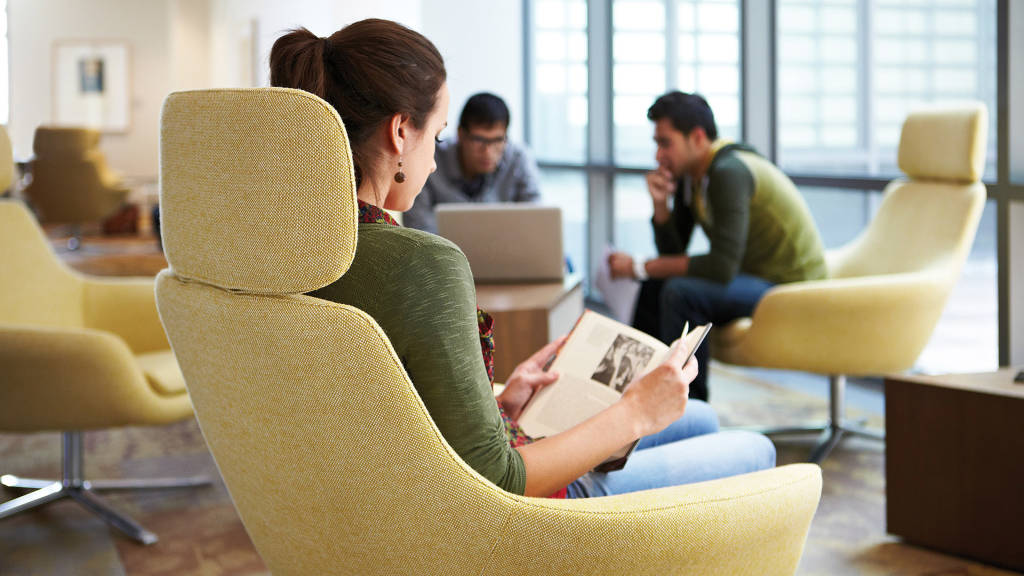
“In the simplest sense, work is action—doing something. Emotions prime our bodies and minds for action,” says Arantes.“The link between the mind and the body is emotion. Humans are biological organisms that evolved in nature. Our survival has depended on our ability to interpret situations around us as safe or dangerous, and then react appropriately. Sensing danger prepares the body to either run or fight. On the other hand, if we are in a safe, supportive environment, our bodies relax and our minds start to wonder about other things.”
An important emphasis, she says, is “how biologically driven this is, because our survival as a species has depended on taking appropriate actions that are triggered by our emotions. We’re constantly evolving organisms that need to be constantly repaired. And when we’re in a negative state of mind, we can’t repair ourselves. While negative emotions are a normal part of life, it’s important that they are appropriate in duration and overbalanced with positive emotions. When people are in environments that support positive emotions, they’re free to be productive, collaborative and creative.”
“When people are in environments that support positive emotions, they’re free to be productive, collaborative and creative.”
Beatriz ArantesSenior Researcher, Steelcase WorkSpace FuturesPositive
Shifting to creative work
As people’s work changes, their needs change. And as needs change, work environments also need to change to remain supportive. The evolution of offices as places primarily for process work to places for creative work has profound implications for wellbeing. Creative work is all about making connections, being open to new ideas, taking risks and experimenting. These behaviors are impossible in a stressed state of mind. For creative work to thrive, the workplace needs to be a supportive and positive environment. For creative work, the workplace matters more than ever, and it needs to do more than ever.
“Companies like Zappos and Google have been capitalizing by taking a more emotional approach to wellbeing and promoting their organizations as fun, creative workplaces,” says Arantes. “They are reaping the benefits in their results and also realizing positive employee morale is an added recruitment incentive.”
Most companies, however, still rely mostly on hunches or trial-and-error approaches to workplace wellbeing. A gap in wellbeing research has been information on the impact of the work environment beyond ergonomics, air quality and other obvious factors. Lacking has been a coherent set of insights into the factors that are important for wellbeing and a plan of action for how organizations can give those factors substance in their spaces. The Steelcase team’s objective was to help fill that gap.
“The premise of our research has been that we don’t want to just understand wellbeing; we want to improve it,” explains de Benoist.
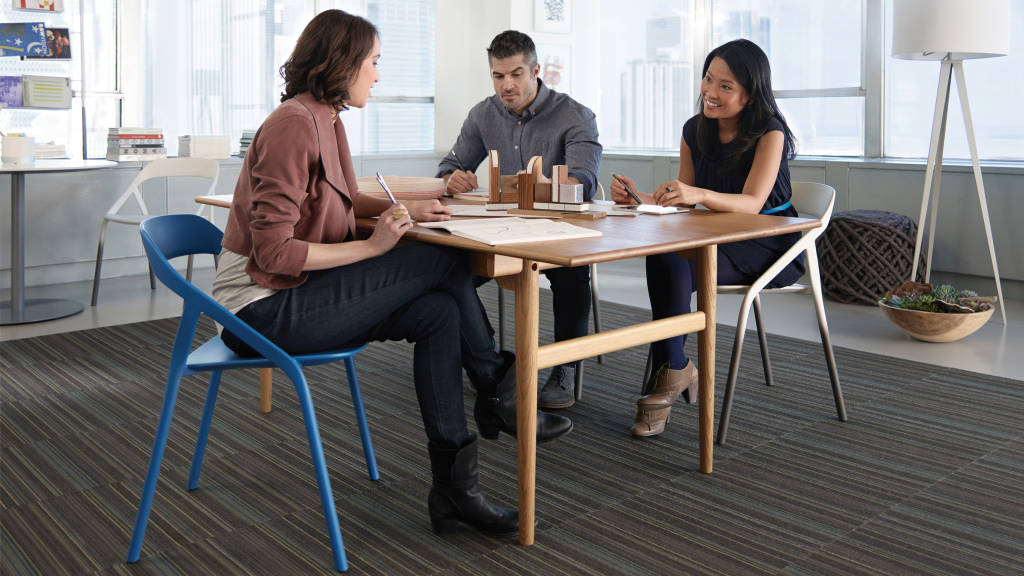
Does Your Work Environment Undermine Wellbeing?
At a recent roundtable conversation on the topic of about the future of work, PopTech curator Andrew Zoli asked a packed room of people where they do their best work. The answer: not at work. People described great cafés, home offices and libraries that helped them to feel energized, focused and engaged. Only one person in the group praised her company’s recently redesigned office as a place where she felt a sense of purpose and vitality.
This conversation echoes many other discussions that are taking place online and in a variety of forums where people are passionately debating what the best work environment is for actually getting work done. Authors Jason Fried and David Heinemeier Hanson recent book “Remote” suggests people don’t need offices at all.
Business leaders disagree. While working remotely is a viable option for some workers, business leaders understand that it’s important for employees to feel connected to each other and with the purpose of their organization. Coming together in the workplace is what allows them to do that. The key is to create workplaces that are designed to be destinations that people want to be in because it helps them do their best work.
Steelcase’s ongoing research sheds light on what workers need to be creative and productive, and identifies some of the most frequent workplace culprits.
Leading organizations can make a significant impact – or hinder – their employees’ wellbeing by focusing attention on the physical environment. With a little effort, people can actually leave work feeling as well, or even better, than when they came in.
Privacy
95% say they need quiet, private spots for confidential conversations
40% say they don’t have them
Focus
95% of workers say having access to quiet, private places for concentrated work is important
41% workers say they don’t have access to quiet spaces
Getting the basics right
50% of workers report that they don’t have pleasing views
40% say they don’t have access to natural light
over 30% say their air quality is bad
37% workers lose up to 30 minutes a day dealing with physical discomfort
Respite
91% of people say they need casual spaces to re-energize
and yet more than half (51%) have no place to go within their workplace.
An Interconnected Workplace: Choice + Control
This framework provides a methodology for creating and assessing a workplace designed for an interconnected world. It recognizes that people need to do both individual “I” work and group “We” work. It also breaks the paradigm that all individual spaces should be assigned or “owned” or that all group spaces should be shared, and instead offers the choice to work in a range of spaces that best supports the work that is being done. The range of spaces in an interconnected workplace need to support focused work, collaboration, socializing and learning, and consider the physical, cognitive and psychological needs of people.
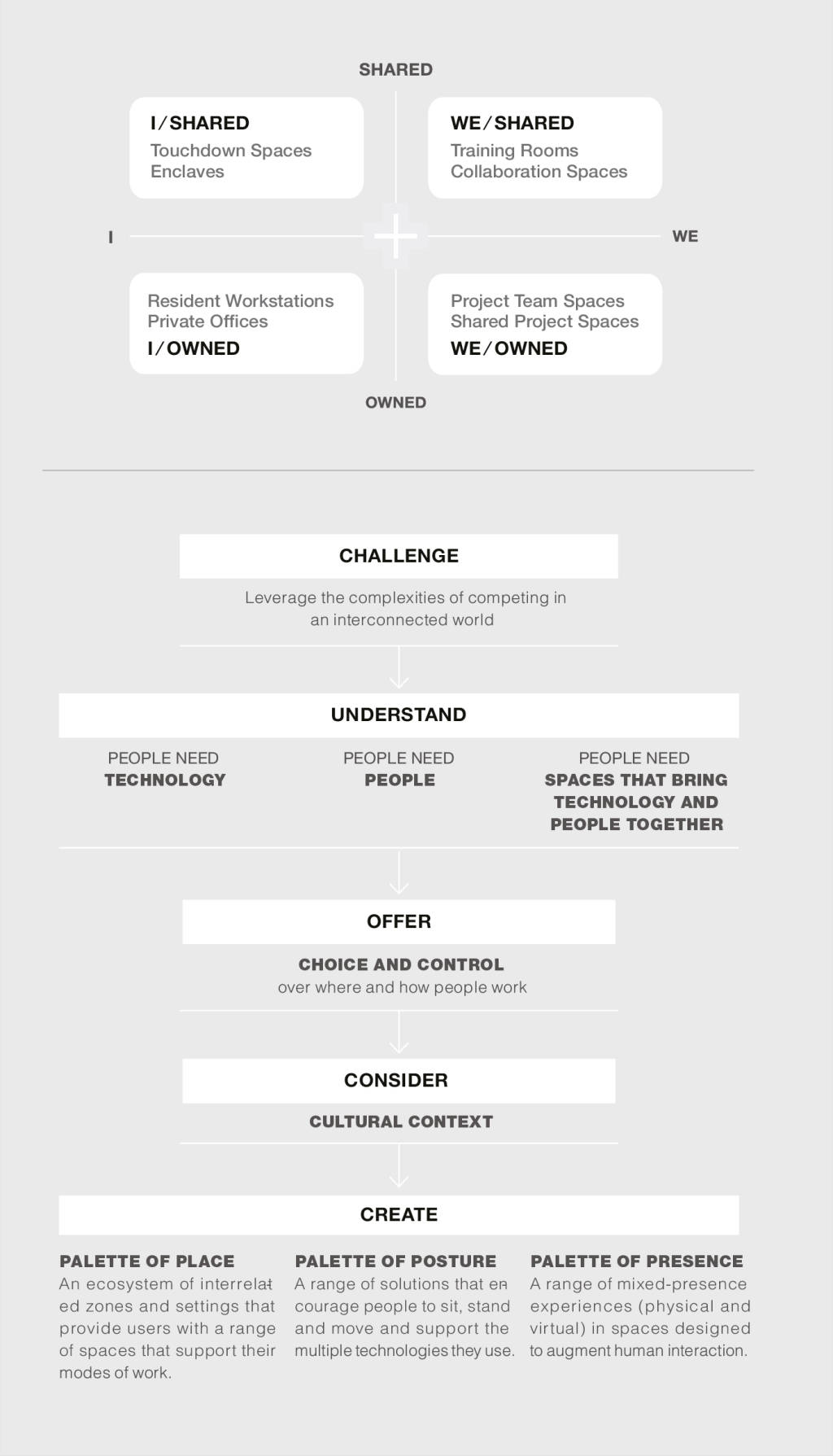
Six Dimensions of Wellbeing in the Workplace
The Steelcase team’s research synthesis identified six dimensions of wellbeing that can be impacted by the design of the physical environment. The foundational concept that links all six dimensions is what Steelcase refers to as an “interconnected workplace,” and which offers employees choice and control over where and how they work.
“To foster wellbeing, employees need to have a variety of work settings that they can choose from,” notes de Benoist. “Traditionally workplaces have been designed for efficiency, and sometimes take a ‘one-size-fits-all’ approach. But that doesn’t offer employees the ability to choose the right kind of setting for the work they need to do. When they have choices, employees have a sense of control that helps them feel more empowered, engaged and less stressed.”
Three key ways to offering this level of choice and control are:
Palette of Place
An ecosystem of interrelated zones and settings that provide users with a range of spaces that support their various modes of work.
Palette of Posture
A range of solutions that encourage people to sit, stand and move while supporting the multiple technologies they use.
Palette of Presence
A range of mixed-presence experiences (physical and virtual) in workplace destinations designed to augment human interaction.
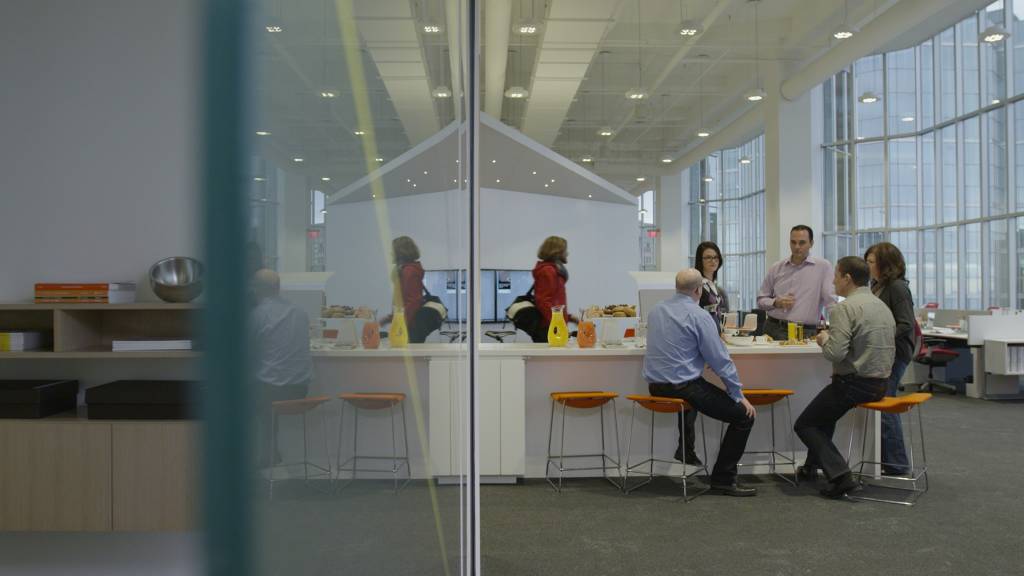
1. Optimism – FOSTERING CREATIVITY AND INNOVATION
Optimism is more than just expecting positive outcomes in various domains of life. It is about being on a quest for discovery, eager to try new approaches versus being overly risk adverse. It means interpreting and remembering events in a positive light, as well as creating enjoyment in the present and seeing possibilities for the future.
Researchers at the University of California recently found that part of our optimism, self-esteem and sense of mastery (the ability to affect a positive change in life) is genetic. But, they also noted that genes are not destiny and that activities, relationships and environment can have almost as much impact in the equation. Emotions can play a significant role in our tendencies toward optimism. Fear breeds pessimism.
Optimism is critical to the type of work that organizations need today: creativity and innovation. It influences a wide range of behaviors such as seeing the big picture, exploring ideas, being open to others, taking more risks and facing difficult tasks. It also makes people open to change. Understood in this way, optimism has important implications for an organization’s agility and resiliency. Because of this, optimistic employees tend be more productive employees in today’s economy.
“Optimism may be the most important job skill in the 21st century,” notes de Benoist. “Organizations are faced with so much volatility and stress that the people who can rise above fears and anxiety are the ones who can help build a culture that is better able to thrive in our world.”
Cultivating optimism in the workplace
Empowering workplaces support continuous experimentation and show the legacy of the brand and organization in positive ways to reinforce progress and possibility. “Workers need to feel a sense of individual influence and control over their environment, versus feeling quashed by standardization and rigidity,” advises de Benoist.
Design Considerations:
- Allow choice and control over where and how people work.
- Create spaces that allow personalization and individual customization, instead of tightly enforced workplace standards.
- Offer settings and affordances that help employees feel supported in their work.
- Design for transparency, so people can see and be seen, and build trust.
- For application ideas designed to support physical, cognitive and emotional wellbeing in the workplace see the Wellbeing Thoughtstarters.
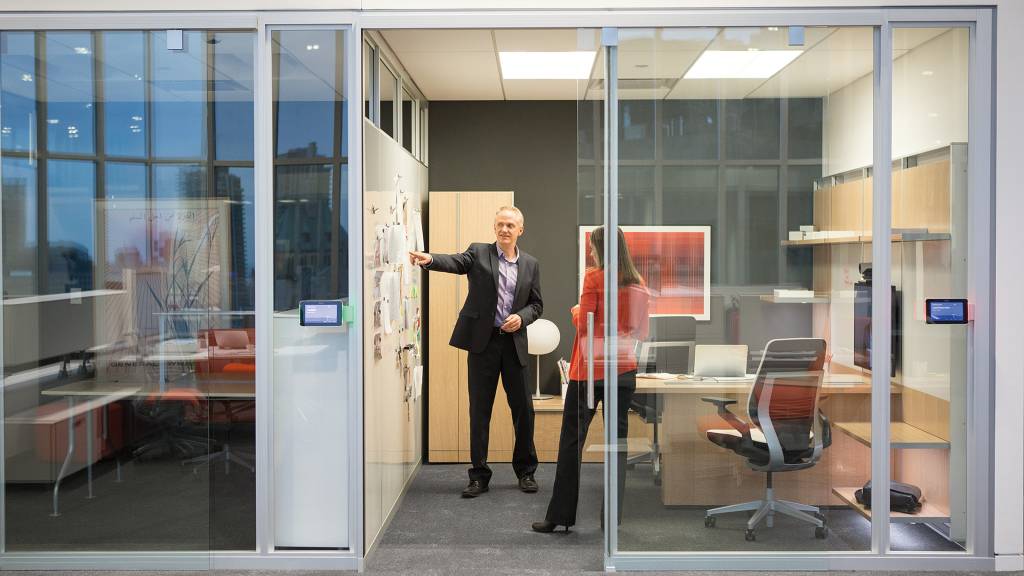
2. Mindfulness – FULLY ENGAGED
Mindfulness means balancing the intense pace of life with being fully present in the moment. Today technology presents many opportunities for multitasking, which allows people to be physically present in a meeting, for example, but mentally lost in email.
The focus on mindfulness in business has grown exponentially as organizations recognize that rapid changes in technology, the marketplace and the global playing field have caused volatility, uncertainty, chaos and ambiguity. These realities create stressful conditions for people in organizations and call for a new style of leadership.
Mihaly Czsikzsentmihalyi, noted psychologist and author of the seminal book “Flow,” relates the notion of flow with his study of happiness and creativity. It’s the antithesis to multitasking and a direct result of mindfulness—i.e., being fully immersed in a feeling of energized focus, full involvement and enjoyment in what you’re doing.
“Mindfulness is a fusion of the mind and body when you lose the notion of time,” says de Benoist. “And it’s not just something you can achieve alone. People can work together in mindfulness, too, performing like a jazz group, all mindful in the moment of now.”
Cultivating mindfulness in the workplace
“Workers need physical spaces that help them manage the cognitive overload of their daily lives and be fully present in the moment,” notes de Benoist.
Design Considerations:
- Create spaces that help people connect with others one-on-one and eye-to-eye, and not just through their technology devices.
- Design areas that allow workers to control their sensory stimulation and choose if they want to amp it up or down.
- Offer places that are calming, through the materials, textures, colors, lighting and views.
- Create areas where people can connect with others without distractions or interference
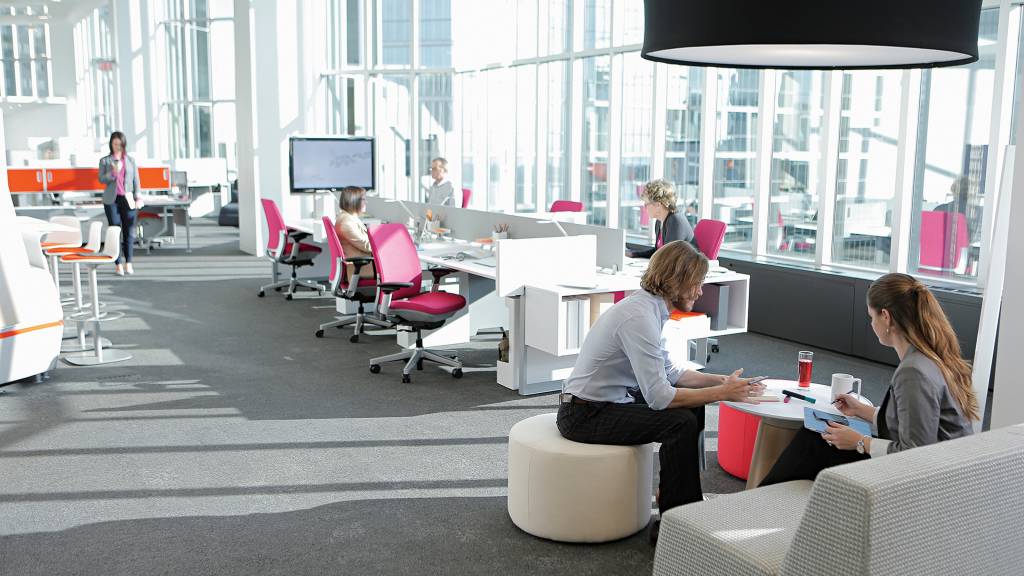
3. Authenticity – REALLY YOURSELF
In workplaces of the past as popularized by Dilbertville and “Mad Men,” allowing yourself to be vulnerable or show emotion at work was considered unacceptable. With “fight or flight” emotions in high gear, many workers are still accustomed to defending themselves by keeping up a pretense of perfection and expected behaviors, which leads to frustration, resentment and unhealthy behaviors.
Wellbeing, in contrast, is cultivated by personal expressiveness — the freedom to be who you are, at work as well as away from work.
Gallup poll data from more than a decade of surveying people has revealed that the most important factor in wellbeing on the job is to have a best friend at work. Relationships anchor people’s commitment to the larger organization. Having close friends and positive interactions can’t happen without trust, which requires authenticity. “Even in Eastern cultures with their legacy of collectiveness versus individualism, the authenticity of self and being able to express that at work is become more important to wellbeing,” says Arantes.
Cultivating authenticity in the workplace
“Workers need spaces where they can feel a part of the organization’s culture, while feeling encouraged to express their own ideas and values,” notes Arantes. “Leaders set standards and a tone of authenticity, while customizable work environments and social settings can reinforce the message.”
Design Considerations:
- Create spaces that help people feel comfortable to express themselves and share their ideas.
- Incorporate informal, non-constricting environments with a home-like feel.
- Design areas that help people connect their personal values to the brand values.
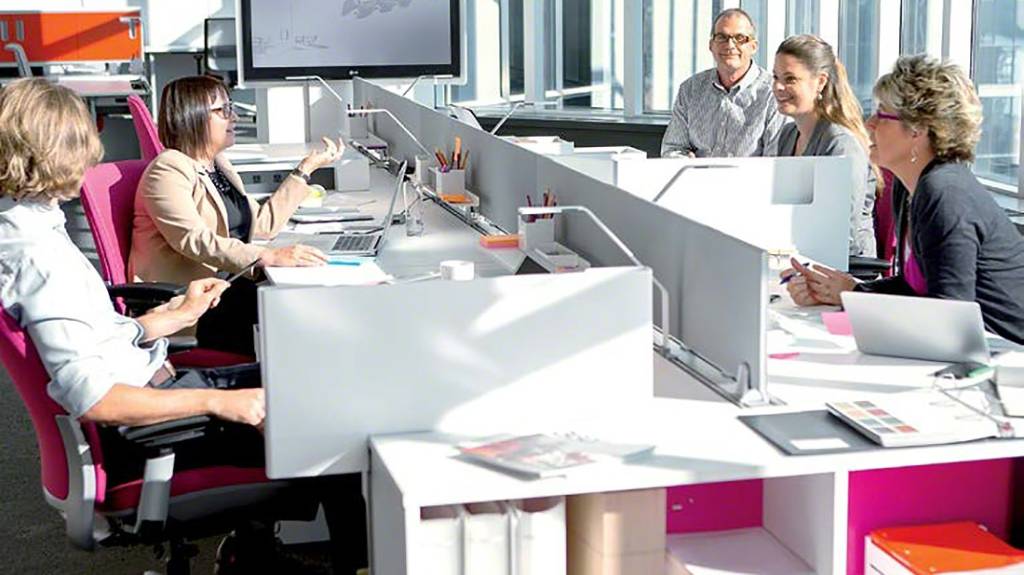
4. Belonging – CONNECTED TO OTHERS
A meaningful life means feeling connected to other people. Social connections at work are sustaining, and feeling useful to others is a powerful way to generate positive emotions.
Psychologist Abraham Maslow positioned belonging at the third level of his famous hierarchy of universal human needs, preempted only by basic physiological needs (food, water, sleep, etc.) and safety/security needs. Numerous studies and experiments have led to the belief that humans are genetically wired to need one another, and Gallup data provides empirical evidence that having close friends and positive interactions at work significantly increases engagement with the organization.
Relationships anchor people’s commitment to an organization, its brand and its purpose. Without meaningful connections to people, organizations can seem anonymous. Because of this, mobility, alternative work strategies and telepresence across geographies must be intentionally crafted so that employees don’t lose their sense of belonging.
“Mobility can be positive because you’re giving people flexibility, and videoconferencing is fast becoming a fact of everyday work, especially for global teams. But it’s important to ensure that people have meaningful connections to others and understand that, wherever they are, they are valued in the organization. Employees need to know they are integral participants in something larger than themselves and others in the organization care about them, ” says Arantes.
Cultivating belonging in the workplace
“As work becomes increasingly mobile and global, creating a sense of belonging is a bigger challenge than ever, but certainly not less important,” says Arantes. “Leading organizations make sure their workplaces provide reasons for people to choose to work there by making it easy to collaborate with co-workers and connect to technologies. They put effort into creating an equal sense of community and belonging for mobile and distributed employees, as well as those physically present.”
Design Considerations:
- Create entrances that are welcoming with visible hosting for people who don’t work there routinely.
- Provide ample and well-equipped spaces for mobile and resident workers to work individually or in teams.
- Offer videoconferencing configurations that allow remote participants to see content in the room and on the walls, and to hear everyone equally.
- Design informal areas for socialization, in person as well as virtually
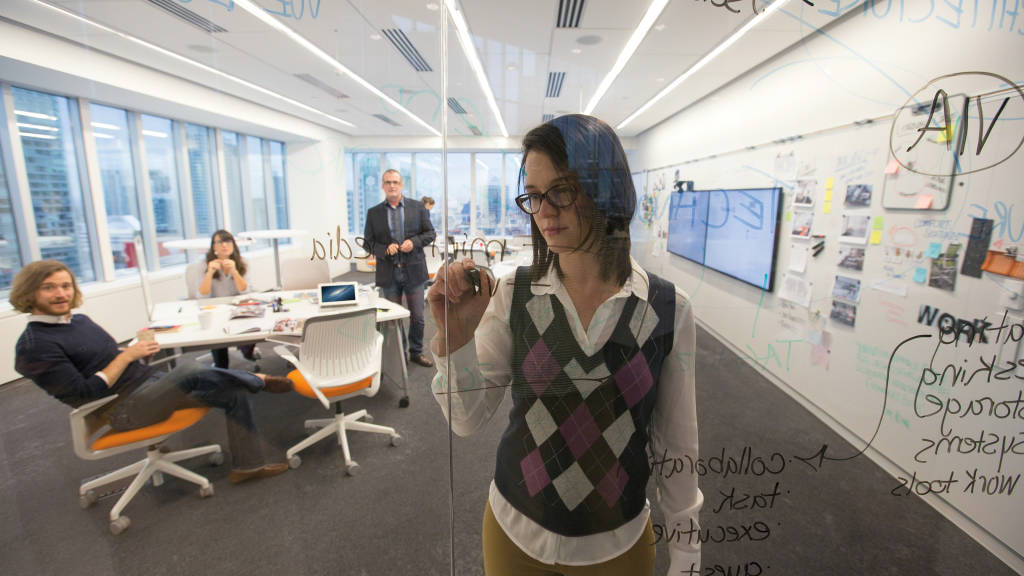
5. Meaning – A SENSE OF PURPOSE
People need to use their strengths, understand their impact and see how they contribute to organizational goals. Edward Diener, nicknamed “Dr. Happiness” and a senior scientist for the Gallup Organization, distinguished that the so-called “calling orientation,” in which people are passionate about what they do, is intrinsically the most rewarding.
A sense of purpose helps build a resilient enterprise based on trust and collaboration. It infuses “yes power” throughout an organization, says de Benoist.
“Beliefs are the rituals of the everyday that a community shares,” he notes. “In the best cases, a person’s sense of meaning in life and the purpose of the company are compatible and augment each other. When people around us believe the same things as we do and work toward similar things in the same space, it creates a sense of harmony in context.”
“Brand isn’t just for the client,” says Arantes. “The brand is also for the people inside the company to have a meaningful understanding of what the brand stands for and be mindful of it in their everyday work.
“Without shared understanding of what you want to accomplish, it’s hard to get people aligned on what their goals are and how to get there. People need meaning in order to know that their work is not going to waste. It’s possible for even a large body of people to move quickly if they’re aligned on the same goal and meaning.”
Cultivating meaning in the workplace
“How we spend our time, doing the right things in the right way, can powerfully impact wellbeing,” says de Benoist. “Spaces that are intentionally designed to help people accomplish meaningful goals can make a tremendous difference in individual performance and overall organizational results.”
Design Considerations:
- Include spaces beyond the lobby that reinforce the brand, purpose, history and culture of the company.
- Leverage vertical real estate to make thinking and progress visible.
- Use technology to display real-time information.
- Create an ecosystem of spaces that give people choices and empower them to work productively alone or together.

6. Vitality – GET UP AND GO
Scientists continue to make breakthrough discoveries about how the mind and body function as an interrelated system. Brain chemistry expert Dr. Candace Pert, a neuroscientist at the U.S. National Institute of Health, wrote in her 1997 book, “Molecules of Emotion,” that receptors and peptides run every system in the human body, creating what she termed a “bodymind’s intelligence.”
Continuing to explore the science of vitality, recent medical studies published in respected journals such as the European Association for the Study of Diabetes and mass media such as The New York Times, have raised awareness of the negative effects of prolonged sitting. Dr. James A. Levine of the Mayo Clinic, a leading researcher in the field of inactivity studies, has noted an explosion of research in this area “because the health care cost implications are so enormous.”
The risks are mental as well as physical, since muscle inactivity produces a series of harmful metabolic effects including a slowdown of the flow of nutrients to the brain, affecting alertness.
Clearly, engaging the body in movement is essential for supporting physical and mental vigor at work. Movement is the body language of ideas,” says de Benoist. “Taking different postures stimulates the mind, and healthy environments encourage people to move, eat well and exercise as healthy practices.”
In addition, sensory experiences in work environments are important, too. Using our senses and nervous system, we interact constantly within the context of spatial environments, processing touch, light and sound and other stimuli that influence mental and physical states. Because stimuli have direct and often immediately perceptible positive or negative consequences, as humans we naturally want choice and control of our environments, seeking out the places that “feel good” to us.
“When you get to the workplace, you need the tools and environments that are going to support you, whether it’s to work alone or have a collaborative session or eat a meal in a pleasant place or go outdoors,” says Arantes. “Providing a palette of place that supports frequent movement is fundamental for sustaining vitality.”
Cultivating vitality in the workplace
How we experience a place affects our actions. Investments in the workplace can completely change employees’ attitudes and behaviors, creating a new spatial vibe that boosts people’s motivation and performance within a relatively short time.
Design Considerations:
- Design areas that give people choices for controlling the level of sensory stimulation around them.
- Provide easily adjustable furniture to fit a range of sizes, needs and preferences and to promote movement throughout the day.
- Include cafés with healthy food choices and displays.
- Bring nature in with daylight, views, ventilation, patios, etc.
- Support active, healthy lifestyles with centrally located stairways, outdoor walking paths, bicycle racks, etc.
Amplifying people’s performance
IBM’s CEO Study notes that the move toward a more collaborative, communicative, creative, flexible, and ultimately more innovative organization is not something they are delegating to HR. They see the challenge as so critical to their business performance that they plan to engage the entire C-suite and personally lead this shift.
To impact this goal, leaders at all levels of the organization will gain greater traction if they incorporate a focus on wellbeing into their strategy. Employers make a significant investment in people and expect a positive ROI over time. For those who understand that their employees’ wellbeing is imperative for bottom line success, the potential return is high. Conversely, it’s shortsighted and risky to shortchange people’s potential with inadequate, unsupportive or uninspiring work environments that undermine their wellbeing.
“Businesses understand that they need people more than ever to get innovative work out the door. It’s really about getting people to blossom,” says Arantes. “In the past leaders may not have recognized the impact employee wellbeing could make. That’s changing, there’s a different mindset.”
Wellbeing is a competitive advantage in today’s business world.
Wellbeing is a competitive advantage in today’s business world. To achieve it, workers need mental and physical health, nurtured by a supportive environment that gives them the emotional capacity to interpret and experience events in a way that leads to productive, positive actions. The best places help people engage deeply in what they do by giving them what they need for wellbeing at work.
The results can be self-perpetuating: a systemic sense of wellbeing that easily becomes positively contagious, amplifying the performance of individuals, teams and the entire enterprise.
Wellbeing Thought Starters:
Application Concepts
Informed by insights from our research, we’ve developed some settings that can be a catalyst for intentionally designing work environments that support the physical, cognitive and emotional needs of people at work.
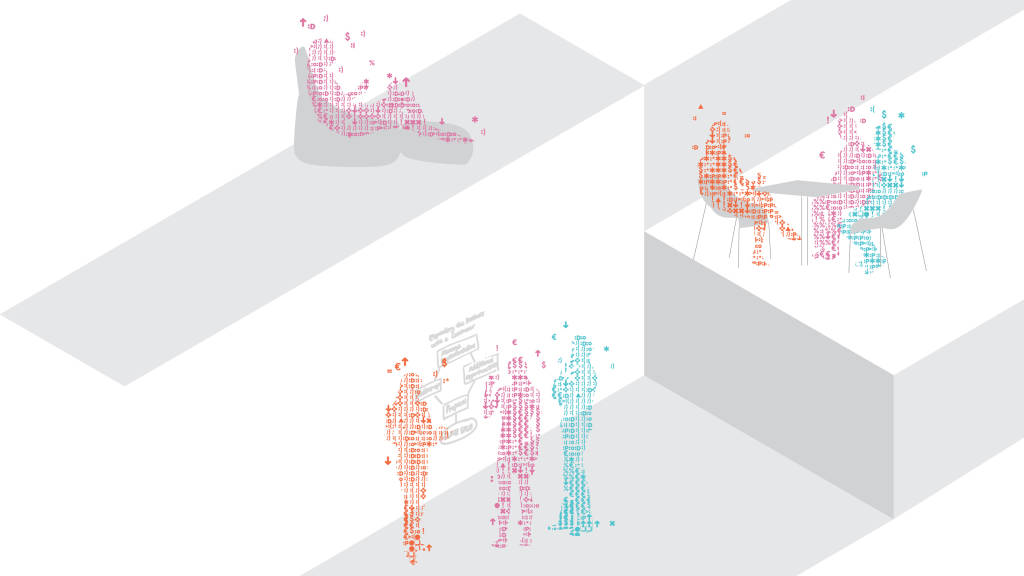
Planning for the Dimensions of Wellbeing
Attaining wellbeing at work is about creating and sustaining a healthy physical and mental state over time in a supportive physical and social environment. No single space can do this alone.
Optimism
Provide spaces that can be easily modified by individuals and teams to encourage experimentation, spark imagination and creativity, and expand possibilities.
Mindfulness
Create environments that support focus and minimize distractions for all tasks by providing a diverse range of settings that facilitate individual concentration, 1:1 connections, collaboration and team focus.
Authenticity
Allow individuals and teams to express their personalities through space by empowering them to select environments that best suit their preferred work styles. Encourage employees to display personal items in workstations and on their computers, tablets and smartphones.
Belonging
Provide spaces that encourage personal and professional connections. Ensure that spaces designed for users to connect with one another are intuitive and easily accessible for both co-located and distributed teams. Embed elements such as a media wall in the space to reinforce the importance of connections and the organization’s commitment to employees.
Meaning
Accommodate both co-located and geographically disparate teams by creating a palette of places and presences — i.e., settings for both physical and virtual collaboration. Provide social spaces to reinforce the importance of fun and social interactions and the company’s commitment to encourage these behaviors.
Vitality
Design spaces that encourage movement. Create a variety of indoor and outdoor spaces that offer posture choices (sitting, standing, perching, lounging) and encourage walking to create physical and emotional energy, stimulate the mind, improve alertness and improve focus.
Wellbeing Dimensions Applied
Project Studios
An immersive, shared space that supports project teams and small groups in analog and digital collaboration, content sharing and idea generation. Well-appointed to meet user needs around tools, hospitality, amplification and posture options.
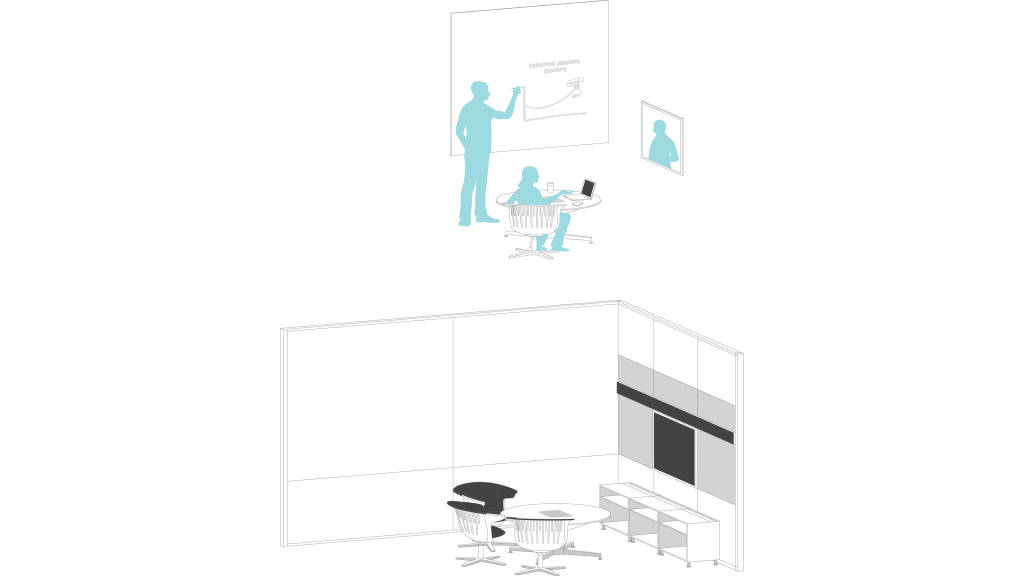
Walls are leveraged as planes for analog and digital collaboration. Chairs swivel so workers can switch eye contact quickly between each other and multiple information displays.
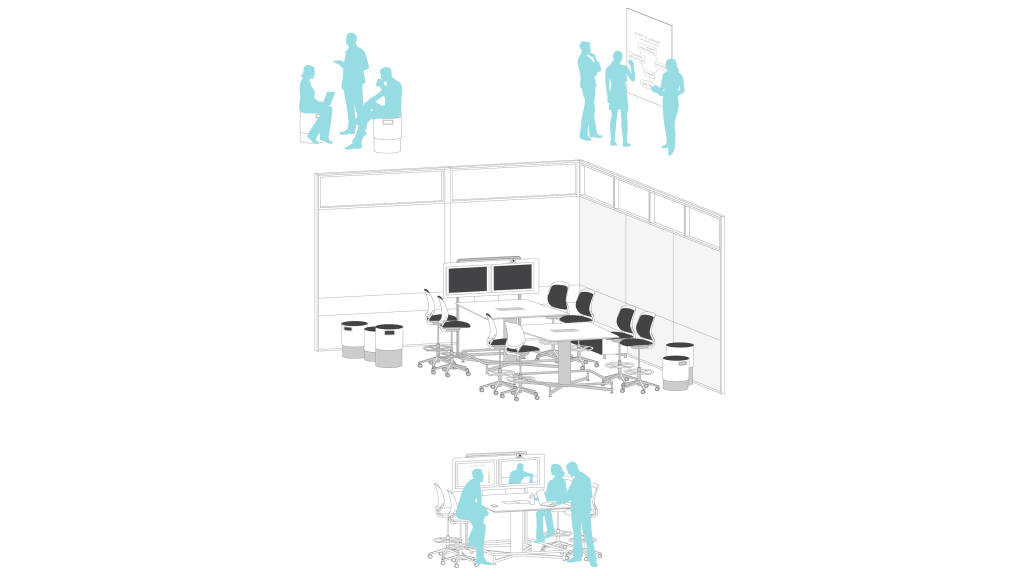
Well-situated high-definition telepresence and furniture amplifies the conditions for innovation by augmenting the quality and quantity of interactions for both physical and virtual participants.
Moveable seating provides informality and postural change. Using walls as vertical planes for displaying information increases mental capacity for dealing with complex issues.
Café
An informal and social setting to support connections, built trust and provide nourishment. Provides opportunities to connect socially and hosts mobile workers graciously to facilitate a sense of belonging, promote healthy professional relationships and bridge presence disparities.
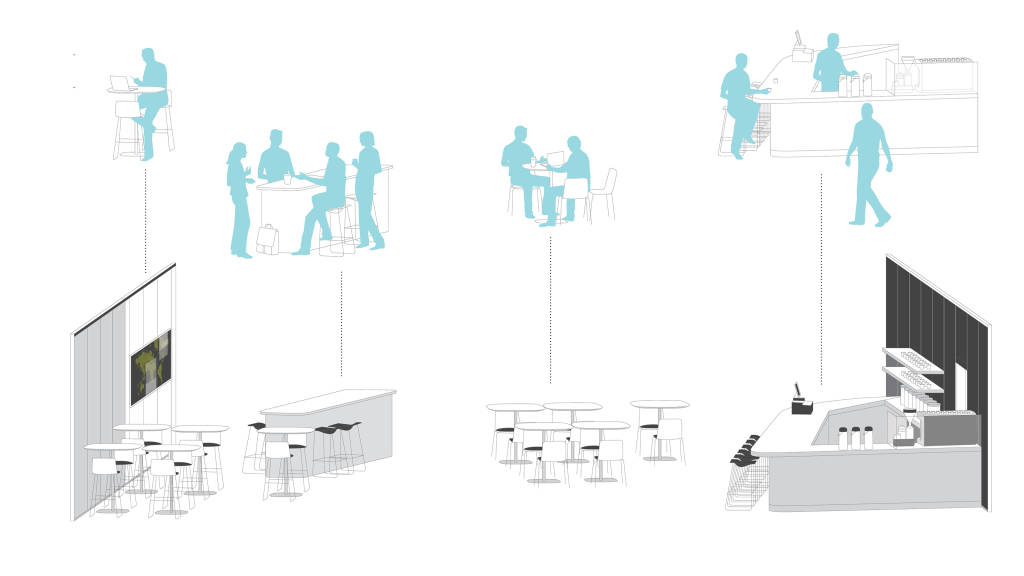
There is a variety of settings for socializing or meeting informally.
Nomadic Camp
An area for mobile users with a variety of settings that welcome and accommodate focus and collaboration. A palette of place and posture options provides solutions for mobile and geographically disparate users to feel a sense of belonging, community and connection to the brand and culture. Shared spaces welcome users and allow for personalization and self-selection, giving a sense of pride and temporary ownership.
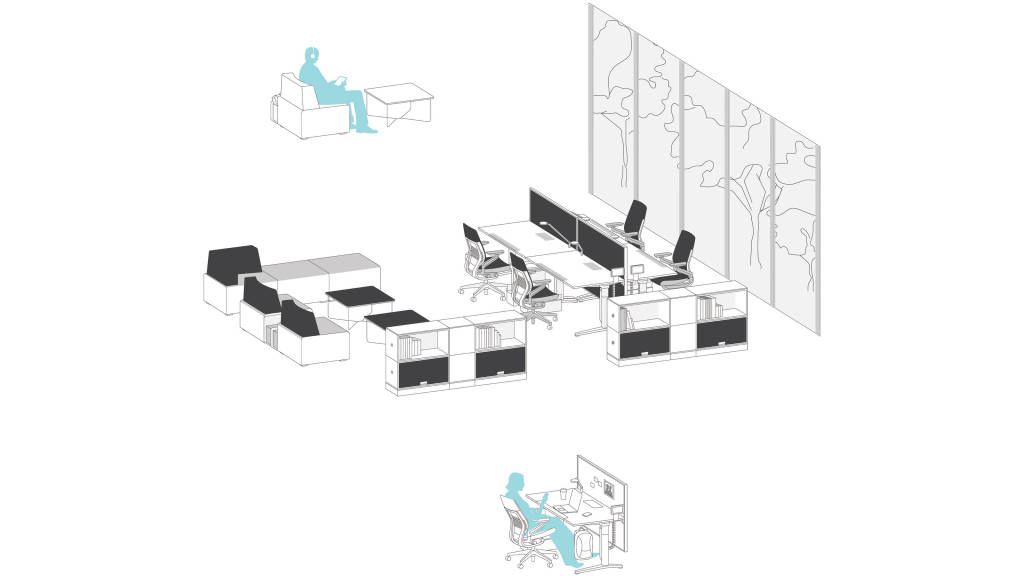
Private Office
An owned space that provides the ability to express one’s self and display personal items and professional artifacts. Users are empowered to utilize the space in the best way to support their individual needs through amplification, making work visible on the walls or providing solitude for focus.
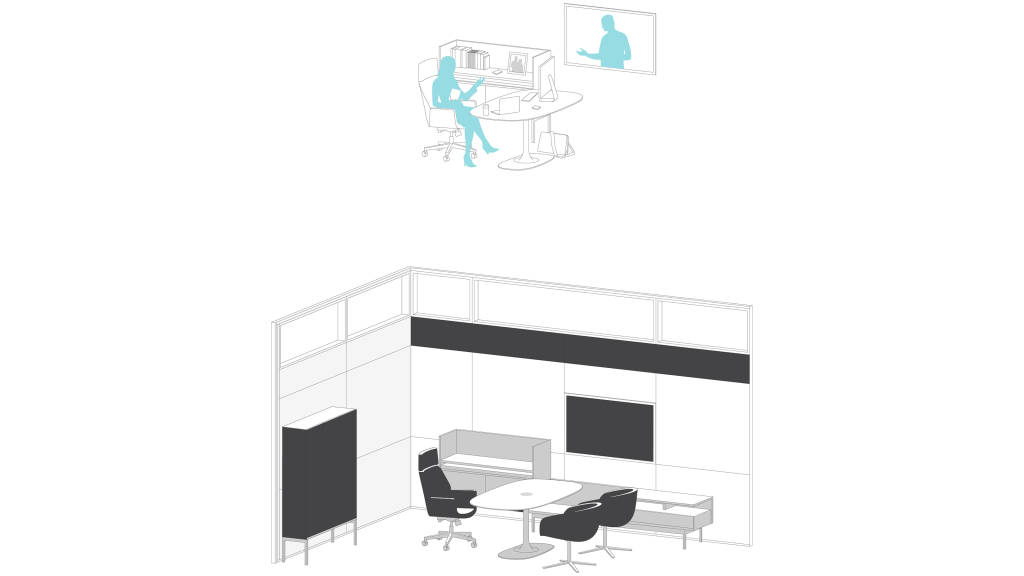
Acoustically sealed, the space supports quick switches from individual focused work to 1:1 connections and interactions.
Patio
A setting that offers inspiring views, access to nature and a palette of place, postures and presence options. Promote movement through the environment by encouraging users to select the right place for a given task. A variety of settings support user needs throughout the day, from focus to respite to collaboration.

Retreat
An informal place that enables people to be alone with others nearby or have informal interactions within the hum of surrounding activity. Provides great views to the outdoors and displays of organizational artifacts.
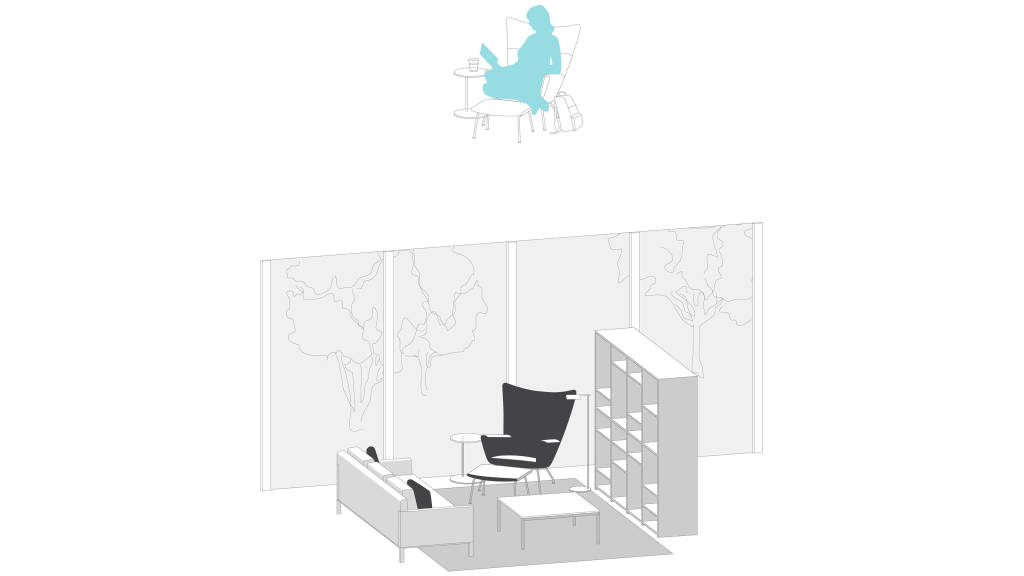
Those who aren’t comfortable in a high-sensory environment can come here to dial down the stimulation around them.
Innovation Suite
A space to fine-tune imagination, spark creativity and foster critical thinking. Inspire, engage and support evolving innovation processes and serve as a symbolic and tangible expression of a company’s commitment to a culture of innovation.
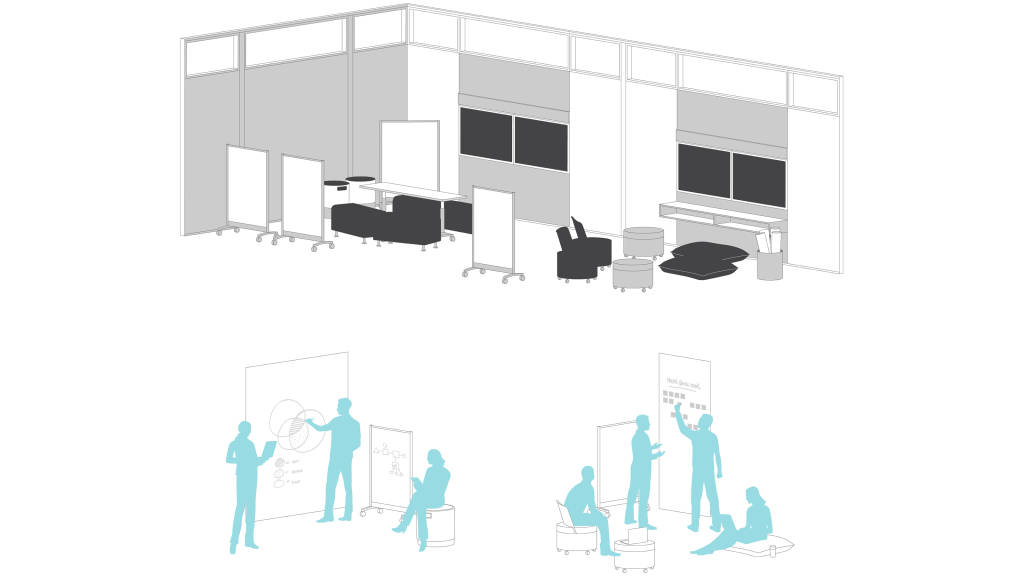
Enclaves
Small, private spaces that provide respite, focus and rejuvenation. Easily accessible with good visual signaling.
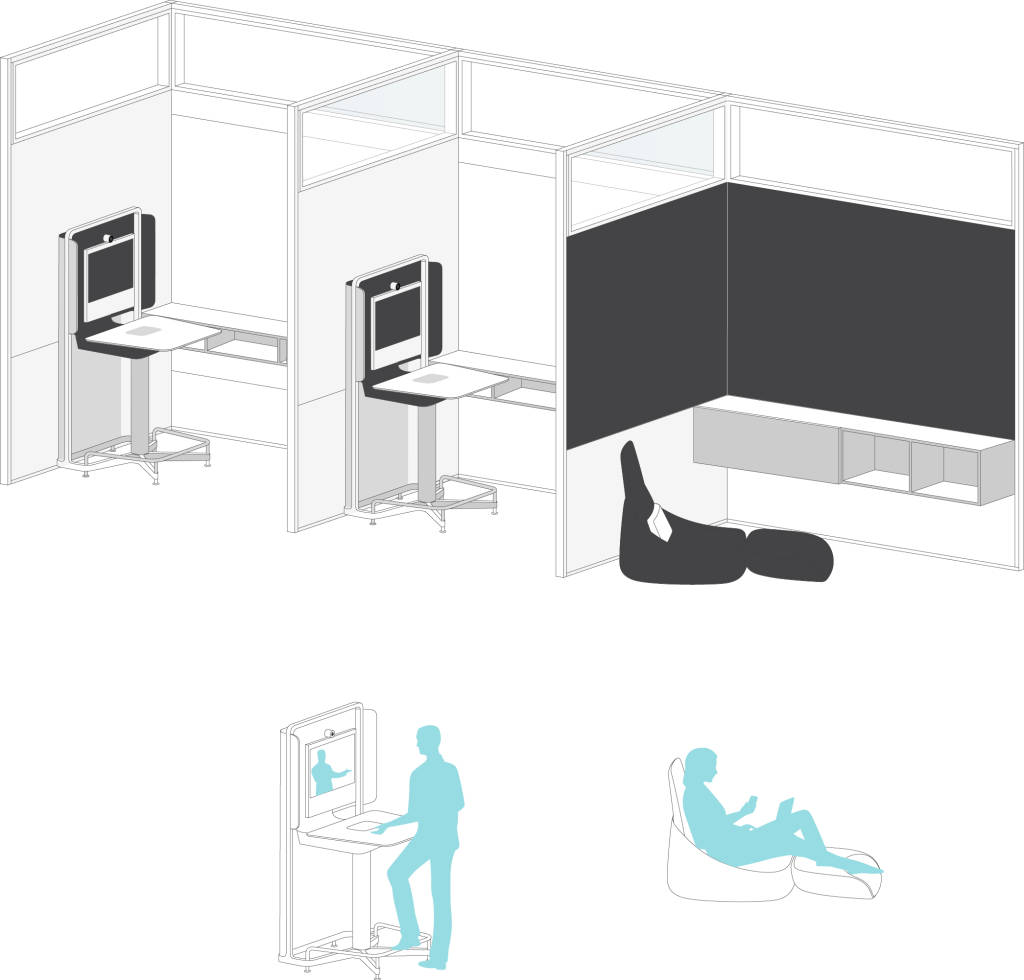
Resident Neighborhood
Owned individual space with supportive tools and personal control. Users can personalize their workstations and adjust for comfort. The overall zone supports a range of user needs, from focused work to collaboration to touch-down tasks, allowing the worker to choose where they feel most productive.
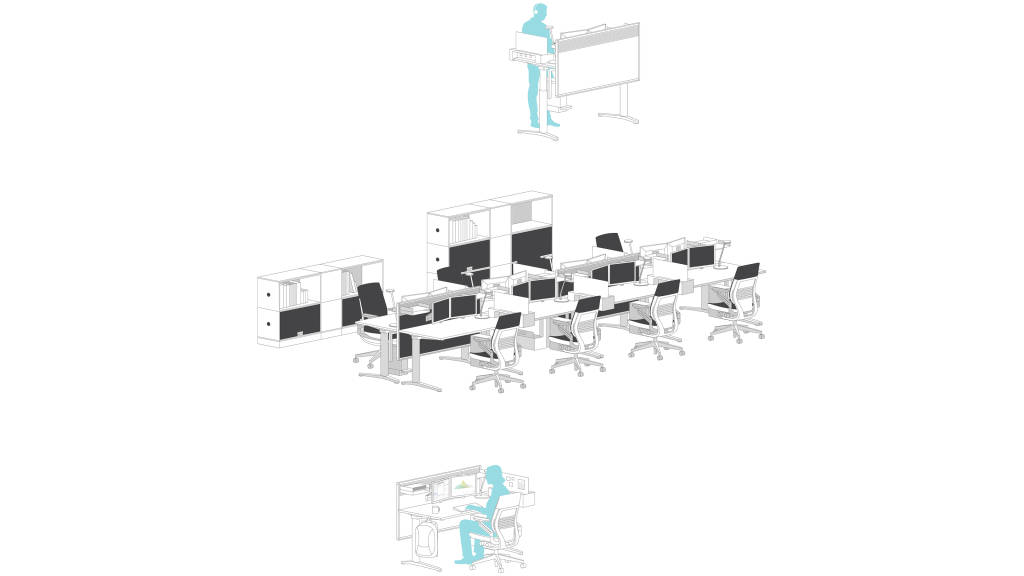
Personal storage cubbies and hooks at each workstation reduce clutter and act as a boundary between workers. Height-adjustable worksurfaces promote healthy movement and mental alertness, while also recognizing workers’ individual physical needs and preferences.
Introducing New Research on Engagement + the Global Workplace
1/3 of workers in 17 of the world’s most important economies is disengaged, according to new research from Steelcase. Working with global research firm Ipos, the Steelcase Global Report is the first to explore the relationship between engagement and the workplace.


